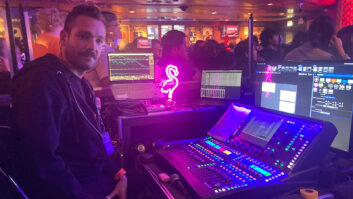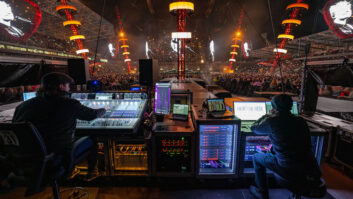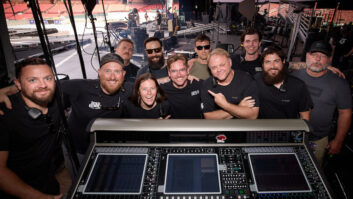Vocalist Aaron Lewis
Photos: Steve Jennings
There’s something to be said for longevity, and front-of-house mixer Jeff Gilmer knows this from his experience with Staind. In addition to producing the band’s demo, he has mixed Staind for the past 10 years. “It’s almost second nature for me.”
Staind hit the road in July of 2005 shortly after their latest release, Chapter V, hit the streets. During the second leg of the tour, the four-piece headlined the Fall Brawl, which included P.O.D., Taproot and Flyleaf. Mix caught up with the tour at San Jose’s Civic Theater in mid-November.
Monitor mixer Scott Boculac (L) and FOH engineer Jeff Gilmer
Knowing this would be a multiple-band tour, Gilmer selected the Yamaha PM5D for its small footprint and flexibility. The only outboard gear he carries is a Summit 200, BSS 901 and a Shure DFR22 — all used on Lewis’ vocals.
With racks and stacks picked up at each stop, the tour carries eight Showco Prism subs to augment whatever the venue has hired. “The band tunes so low and the extra subs down in the center really hit home,” Gilmer says. “We go through it every day to time-align and tune them to work on the different systems.”
Drummer Jon Wysocki
Throughout the tour, Gilmer has worked with nearly every line array that’s available. “I’ve seen ’em all,” he says. “In the long run, this is better for me because it keeps me on my toes, keeps my chops fresh.” Gilmer uses a Clair iO so that he can EQ, compress and limit the different sections of the P.A. as necessary.
Over in monitor world, Scott Boculac is balancing the fact that Lewis and Wysocki are using personal monitors (Shure PSM700s with Ultimate Ear UE7 earpieces), while Mushok and April are on wedges. “I like mixing for [personal monitors], but it’s a matter of personal preference,” Boculac says. “If [the artists] don’t like it, it’s not for me to say what’s right or wrong. It’s whatever the artist is most comfortable with and whatever is going to help them give the best performance.”
The tour is carrying the entire monitor system, which includes a Yamaha PM5D-RH console, Clair 12AM II wedges with Crown power and a Clair iO crossover. Sidefills are a pair of Showco Prism Blue cabinets and a Prism sub. In addition to the personal monitors, Wysocki gets a pair of Clair 12AM IIs and a pair of Clair ML18 subs for monitoring.
Guitarist Mike Mushok
“The trickiest thing with these guys is that the drummer has a signature style,” Boculac reports. “He’ll play nothing but cymbals for measures at a time. To keep in time, the guitar player has to hear that, so I’m constantly riding my overhead mics, my rides and hi-hats into that stage-right floor wedge because he’s not [using personal monitors]. The way I set up the board is that I have everything I need for my stage-right guys by my left hand, and with my right hand, I mix the in-ears for the singer and drummer.”
Shure has long been a microphone supplier for Staind. Lewis is singing through a wireless U2/U4 Shure 58, although an 87 may be tapped to eliminate some electric guitar leakage that’s finding its way into his mic. Wysocki’s kit gets a Beta 52 and SM91 on the kick, two SM57s on snare, SM81s on hi-hat and ride, SM98s across the toms and KSM32s for overheads.
Bassist Johnny April
Mushok’s guitar setup includes two amps: a Marshall JMP preamp and a 9200 Power Amp for a classic rock sound and a Diezel VH4 for a more metal sound miked with SM57s and Beta 52/KSM32, respectively. “I get him to punch through as much mid as he can because he’s tuned so low that without any mids, it’s really difficult to fit into the mix,” Gilmer says. Bass is captured pre and post. April uses two Ampeg SVT-810E cabs with the horns disabled, two SVT-18s and a 2-inch JBL horn. Gilmer uses a Beta 52 on the SVT-810E cabinets and a KSM32 on the horn.
The key from Gilmer’s point of view is creating continuity between the sound from each of Staind’s five releases and what’s happening onstage. “I don’t mix the band live the way the record sounds,” he says. “I try to interpret it my own way, but I try to keep it consistent with what the band sounds like so that when you hear them, you say, ‘Oh, yeah, this is Staind.’”
David John Farinella is a San Francisco — based writer.







